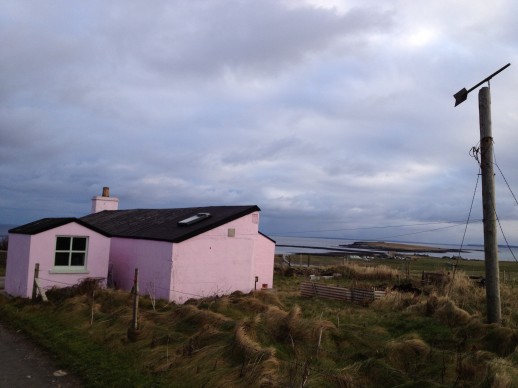
In which, as the year comes to its end, our friends and collaborators look back and share their moments:
Just over a year ago I washed up back on Orkney for what I thought would be a temporary stay. I was applying for jobs in London and hoping to be back in my ‘real life’ soon. It’s still surprising to me that, as the year ends, I have voluntarily decided to go even further from the city: I’m spending the winter on Papa Westray – known as Papay – the most north-westerly and one of the smallest inhabited Orkney islands – just four miles long by one mile wide with 70 residents.
In February I saw an advert in local newspaper The Orcadian and, unexpectedly, spent the summer working for the RSPB on an ongoing project to conserve the endangered corncrake. The job opened up new ideas and possibilities to me and driving around the islands listening for the birds at night was a rediscovery of the place where I grew up.
Here on Papay, I’m staying in the warden’s cottage – the ‘birdie wife’s hoose’ – usually empty in the winter and named Rose Cottage more for its lurid pink paint job than any flowers. I arrived a month ago with my laptop, a 3kg bag of porridge and thermal underwear. After I check that the broadband is working, I light the fire – the house doesn’t have much insulation but with a fire burning it’s cosy enough. From the kitchen, looking south across to the islands of Eday and Westray, the sun travels in a smaller arc each day until midwinter next week. Here, the sea is in every direction and I am constantly aware of being on an island. During storms, sea spray can be blown the whole way across.
The north end of Papay is an RSPB reserve and standing at the top of the cliffs, with nothing but ocean until the Arctic, it feels like you’ve come to the edge of the world. Out to sea, white breaking waves mark the churning of ‘The Bore’, where the currents of Atlantic meet those of the North Sea.
I get outside everyday and have set tasks to sustain myself over the winter. I’ve heard that, to the north west, you can see Fair Isle on a clear day and I scan the horizon with binoculars. I search for groatie buckies – a small, pink, prized shell – and am looking for a perfect ‘bread stone’ to go in the oven. I’ve been tracking my walks using the GPS app on my phone, around the loch in a recreation of an ancient pilgrimage ritual meant to cure the blind, along sheep trails and high water lines. I’ve been photographing patterns and trying to be aware of phases of the moon and understand the tides. I pick up driftwood for the fire – best done after a full moon or a gale, the most fruitful coast depending on which way the wind had been blowing.
It took being away from Orkney for a decade to allow me to return with a new appreciation of what is special and interesting about the islands. Writing my Curious Isles columns for Caught By The River gave me an outlet to describe some of the experiences I had over the year including spending a night on the abandoned island of Copinsay, rebuilding sections of dry stone dyke on my Dad’s farm and joining an eccentric group who swim in the sea year round.
My centre of gravity has moved north this year – I’ve visited Shetland and Iceland and am planning a journey to Fair Isle, just over the horizon. I am still shocked by how I ended up in rehab last year, that I haven’t drunk alcohol for a full calendar and that I’m back here, on these windy rocks, calling for hope on my imagination and surroundings. A couple of days ago I found a starfish at the top of the cliff – it could only have got there by being dropped by a bird.
Nearby, on the uninhabited skerry of Rusk Holm, a stone tower with a spiraling walkway was built so that, at the highest tides, the hardy ‘holmie’ sheep that live there eating seaweed could climb to escape being swept away by the strongest waves and drowning. Right now this little island is my Rusk Holm Tower, somewhere I can breathe as the churning waters rise below.